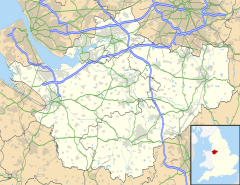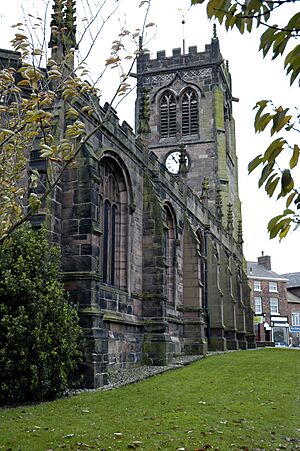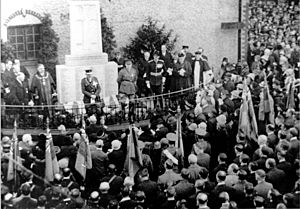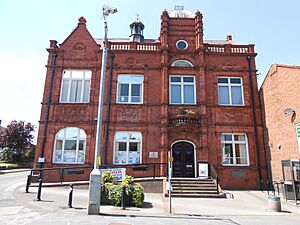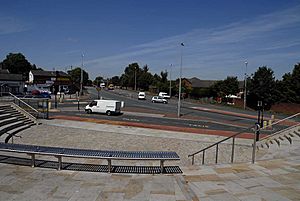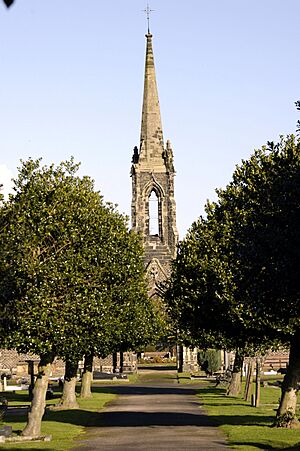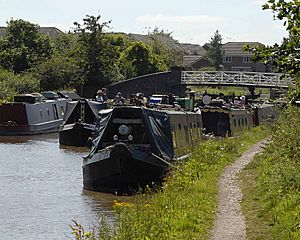Middlewich facts for kids
Quick facts for kids Middlewich |
|
|---|---|
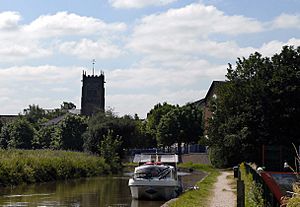 The parish church of St. Michael and All Angels seen over the Trent and Mersey Canal |
|
| Population | 13,595 (2011 Census) |
| OS grid reference | SJ704663 |
| • London | 153 miles (264 km) SE |
| Civil parish |
|
| Unitary authority |
|
| Ceremonial county | |
| Region | |
| Country | England |
| Sovereign state | United Kingdom |
| Post town | MIDDLEWICH |
| Postcode district | CW10 |
| Dialling code | 01606 |
| Police | Cheshire |
| Fire | Cheshire |
| Ambulance | North West |
| EU Parliament | North West England |
| UK Parliament |
|
Middlewich is a town in Cheshire, England. It's part of Cheshire East, a local government area. The town is about 19.2 miles (30.9 km) east of Chester. In 2011, about 13,595 people lived there. Middlewich is part of a larger group of towns called the Central Cheshire conurbation, which has about 130,000 people.
Middlewich is special because three rivers meet there: the Dane, Croco, and Wheelock. Also, three canals pass through the town: the Shropshire Union, Trent & Mersey, and the Wardle Canal. The town has good road links, including the A533, A54, and A530. It's also easy to get to bigger cities like Manchester and Liverpool from Middlewich.
Since 1970, the town's population has doubled. This shows that many people choose to live in Middlewich even if they work elsewhere. Over the years, Middlewich has worked to attract more visitors. It hosts events like the yearly folk and boat festival, Roman and Norman festivals, and regular farmers' markets. In 2014, Middlewich was even named one of the best places to live in England based on its postcode area.
Contents
- Discovering Middlewich's Past
- How Middlewich is Governed
- Middlewich's Location and Climate
- Who Lives in Middlewich
- Middlewich's Economy and Jobs
- Fun and Community in Middlewich
- Media in Middlewich
- Important Places and Churches
- Getting Around Middlewich
- Learning and Schools
- Famous People from Middlewich
- Images for kids
- See also
Discovering Middlewich's Past
The name "Middlewich" comes from old English words. "Wich" or "wych" often meant a place where salt was made. So, Middlewich was the "middle" salt town between Northwich and Nantwich. In the Domesday Book, a very old survey from 1086, it was called "Mildestvich."
Ancient Roman Salt Production
Middlewich was first built by the Romans. They called it Salinae because of the large salt deposits nearby. It became a major Roman site for producing salt. This activity was mostly in an area called Kinderton, just north of the church. Some people think salt was made here even before the Romans, but there's no proof yet. The Romans even built a fort (a military camp) at Harbutts Field. Digs have found Roman wells and parts of old Roman roads.
Salt's Importance Through History
Salt making has been the main industry in Middlewich for 2,000 years. It has really shaped the town's history. Before the Norman invasion in 1066, there was likely one salt pit. After the Normans took over, a family called the Venables became important landowners. They built a large house east of the town.
Battles and Growth in Middlewich
Middlewich saw two important battles during the English Civil War. On March 13, 1643, the first first Battle of Middlewich happened between the Parliamentarians and the Royalist supporters of King Charles I of England. The second Battle of Middlewich took place on December 26, 1643. Many soldiers lost their lives in these fights.
The town grew a lot in the 1800s and 1900s. More people were needed to work in the salt and chemical factories. In the mid-1800s, Middlewich was known for farming, a silk factory, and its salt works. By 1911, it also had chemical factories and made condensed milk.
Remembering the Wars
Like many towns, Middlewich lost many young men in the First World War. A cenotaph (a monument to those who died) near the church lists 136 men who died. This was about 10% of the town's men aged 15 to 45. Forty-two people from Middlewich died in the Second World War, and one in the Korean War.
Modern Changes and Development
After the World Wars, many new houses were built. In the 1970s, a new road called St. Michael's Way was built. This helped traffic move through the town more easily, avoiding the main shopping street. Since the 1980s, even more new homes have been built. People are drawn to Middlewich because it's close to the M6 motorway and has affordable land for building.
How Middlewich is Governed
Middlewich has been part of Cheshire for a very long time. Today, it is governed by Cheshire East Council. The town also has its own town council, which handles local issues. The town council is based at Middlewich Town Hall.
Middlewich is part of the Mid Cheshire area for national elections. The person who represents Middlewich in the UK Parliament is called an MP. The current MP is Andrew Cooper from the Labour Party.
Middlewich's Location and Climate
| Weather chart for Middlewich | |||||||||||||||||||||||||||||||||||||||||||||||
|---|---|---|---|---|---|---|---|---|---|---|---|---|---|---|---|---|---|---|---|---|---|---|---|---|---|---|---|---|---|---|---|---|---|---|---|---|---|---|---|---|---|---|---|---|---|---|---|
| J | F | M | A | M | J | J | A | S | O | N | D | ||||||||||||||||||||||||||||||||||||
|
70
6
1
|
50
7
1
|
60
9
3
|
50
12
4
|
60
15
7
|
70
18
10
|
70
20
12
|
80
20
12
|
70
17
10
|
80
14
8
|
80
9
4
|
80
7
2
|
||||||||||||||||||||||||||||||||||||
| temperatures in °C precipitation totals in mm |
|||||||||||||||||||||||||||||||||||||||||||||||
|
Imperial conversion
|
|||||||||||||||||||||||||||||||||||||||||||||||
Middlewich is located at 53°11′31″N 2°26′35″W / 53.19194°N 2.44306°W. It's where the Dane, Croco, and Wheelock rivers meet. The town is about 2.5 miles (4.0 km) from Junction 18 of the M6 motorway.
Three canals run through Middlewich: the Middlewich Branch of the Shropshire Union Canal, the Trent and Mersey Canal, and the Wardle Canal. The Wardle Canal is very short, only about 100 feet (30 m) long, making it the shortest canal in the UK!
The town is built on flat land with large salt deposits. The weather in Middlewich is generally mild. Temperatures are usually average for the UK, and it gets a bit more sunshine than the national average. The amount of rain is slightly below average.
Who Lives in Middlewich

In 2001, Middlewich had a population of 13,101 people. The town has a younger population compared to the rest of the UK, with more children. Homes in Middlewich are also a bit larger than the national average, with about 2.51 people per house. Most homes (almost 85%) are owned by the people who live in them.
Most people aged 16 to 74 in Middlewich are working. About 77% of residents drive to work. A smaller number work from home, use public transport, walk, or cycle.
| Population of Middlewich since 1801 | |||||||||||||||||||
|---|---|---|---|---|---|---|---|---|---|---|---|---|---|---|---|---|---|---|---|
| Year | 1801 | 1841 | 1851 | 1891 | 1901 | 1911 | 1921 | 1931 | 1939 | 1951 | 1961 | 1971 | 1981 | 1991 | 2001 | 2011 | |||
| Population | 1,190 | 1,242 | 1,235 | 3,706 | 4,669 | 4,909 | 5,115 | 5,458 | 6,390 | 6,736 | 6,863 | 7,853 | 8,300 | 11,913 | 13,101 | 13,595 | |||
| Sources: | |||||||||||||||||||
Most people in Middlewich identify as Christian. A small percentage did not state a religion or said they had no religion.
Middlewich's Economy and Jobs
Middlewich has a traditional main street with many small shops. You can also find five supermarkets there. Historically, the main jobs were in the salt industry and farming. Salt is still made at a company called British Salt, which employs about 125 people.
Because Middlewich is close to the M6 motorway, many distribution and business parks have been built. Big companies like Tesco have warehouses here. The Ideal Standard factory, which has made bathroom fixtures since 1937, employs about 300 people.
Tourism is growing in Cheshire, and Middlewich's canals are a big draw. The annual Folk and Boat Festival brings in many visitors and boosts the local economy.
Fun and Community in Middlewich
Middlewich is famous for its annual Folk and Boat Festival. It started in 1990 and brings in about 30,000 visitors and 400 narrowboats over three days. The festival features many folk artists playing around town.
The town also hosts other events, like the Middlewich Roman Festival. In 2001, this festival led to the building of a Roman theatre at the Bull Ring. This theatre is now used for concerts and even an ice-rink! There have also been Norman Festivals and plans for an Industrial Festival.
Middlewich has local newspapers, the Middlewich Guardian and Middlewich Chronicle. There's also a local radio station, Mid-Cheshire Radio. The town library has Roman artifacts on display. Fountain Fields is a town park with a bowling green, owned by the council since 1926.
Sports and Healthcare
Middlewich has a football club, Middlewich Town, which plays in the Mid-Cheshire League. There's also a cricket club. The town has a leisure centre that shares facilities with the high school.
For healthcare, Middlewich residents use Leighton Hospital near Crewe. There are also two local doctor's offices and two dental practices.
Media in Middlewich
Local news and TV shows for Middlewich come from BBC North West and ITV Granada. You can listen to local radio stations like BBC Radio Stoke, Hits Radio Staffordshire & Cheshire, Greatest Hits Radio Staffordshire & Cheshire, and Silk Radio. The local newspapers are the Middlewich Guardian and the Chester Chronicle.
Important Places and Churches
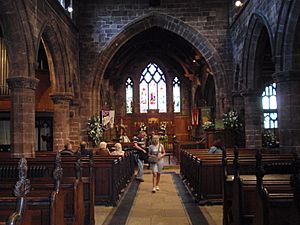
The most important building in Middlewich is the Anglican parish church of St Michael and All Angels. Parts of it are from the 1100s, but most was built between the 1300s and 1500s. The church was a key site during the English Civil War battles.
Other important places include the Roman Theatre at the Bull Ring and the town bridge, which opened in 1931. Middlewich also has a town cemetery with a chapel from 1859. It contains the graves of 21 British service members who died in the World Wars.
The Victoria technical school and library, built in 1897, is a distinctive red brick building. Since 1900, it has been used as offices for the Town Council. Just north of town is Ravenscroft Hall, built in 1837.
Middlewich has churches for five Christian groups: Church of England, Methodist, United Reformed Church, Catholic, and Pentecostal.
- The Middlewich Methodist Church was built in 2000.
- The Middlewich United Reformed Church was founded in 1797. The current church was built in 1870.
- Catholic services started in a cottage in 1848. The modern St Mary's Catholic Church was built in 1890.
- Middlewich Community Church is a newer Pentecostal church.
Getting Around Middlewich
Roads for Travel
Middlewich is connected by several main roads:
- The A533 goes north to Northwich and Runcorn, and south to Sandbach.
- The A54 connects to Chester and Winsford in the west, and Holmes Chapel and Buxton in the east.
- The A530 links to Crewe and Nantwich to the south.
Bus Services
Two local bus routes run through Middlewich:
- Route 37: From Crewe to Northwich.
- Route 42: From Crewe to Congleton.
Train Connections
The closest train stations are:
- Winsford, about 2.3 miles (3.7 km) away, for trains to Crewe and Liverpool Lime Street.
- Holmes Chapel, about 4.3 miles (6.9 km) away, for trains to Crewe, Stockport, and Manchester Piccadilly.
Middlewich used to have its own train station, but it closed to passengers in 1959. The railway line is still used by freight trains. There are plans to reopen the line for passengers and build a new station in Middlewich.
Canal Routes
The Trent and Mersey Canal was rerouted to pass through Middlewich in the 1700s. It connects with a branch of the Shropshire Union Canal. The short Wardle Canal links these two waterways.
Nearby Airports
Middlewich is about 19 miles (31 km) from Manchester Airport, one of the busiest airports outside London. It's also 26 miles (42 km) from Liverpool John Lennon Airport.
Learning and Schools
In the mid-1800s, Middlewich had three schools. A Church of England school was built in 1854 and later became known as the National School. Today, there are seven schools in Middlewich: one infant school, one junior school, four primary schools, and one secondary school.
Middlewich High School opened in 1906. It has been improved over the years with better teaching areas and a sports hall that the community can use. In 2007, it was ranked 34th out of 50 schools in Cheshire for GCSE results.
Famous People from Middlewich
Many interesting people have come from Middlewich:
- John Hulse (1708–1790) was a religious scholar who started special lectures at Cambridge University.
- Theophilus Lindsey (1723–1808) was a religious leader who helped start important debates within the Church of England.
- Elizabeth Ashbridge (1713–55) was an 18th-century Quaker minister.
- William Benbow (1787–1864) was a preacher and publisher who fought for more people to have the right to vote.
- Charles Frederick Lawrence (1873–1940) was a local historian who wrote about Middlewich's early history. He even found an ancient stone tool!
- John Wright Oakes (1820–1887) was a landscape painter whose work was shown at the Royal Academy.
- Craig McDean (born 1964) is a famous British fashion photographer.
- James Hargreaves (1834–1915) was a chemist and inventor who developed a way to make chemicals from salt water.
- Jack Wilkinson (1931–1996) was a footballer who scored 81 goals in 158 games.
Images for kids
See also
 In Spanish: Middlewich para niños
In Spanish: Middlewich para niños


